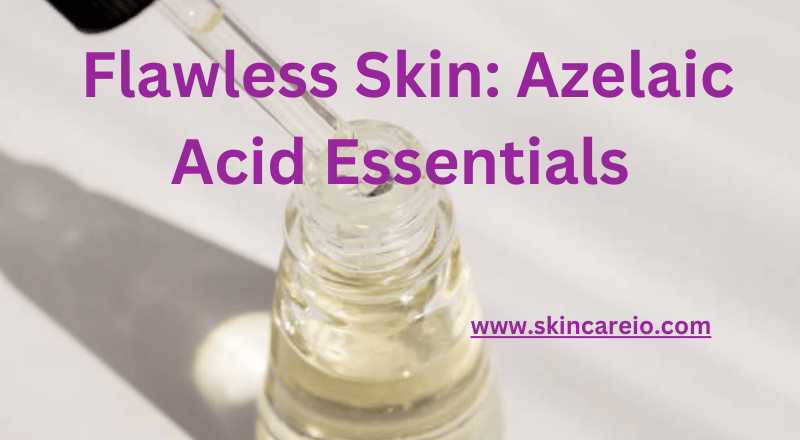Azelaic acid is a remarkable skincare ingredient that has gained significant popularity in recent years due to its wide range of benefits for the skin. This naturally occurring acid, derived from grains like barley, wheat, and rye, has been used for decades to treat various dermatological conditions. Today, azelaic acid is a key player in the world of skincare, thanks to its versatility and effectiveness in addressing a multitude of skin concerns.
Azelaic acid, also known by its chemical name dicarboxylic acid, is a saturated dicarboxylic acid that belongs to the family of carboxylic acids. It is a naturally occurring substance found in various grains and has been used for centuries in traditional medicine for its medicinal properties. In skincare, azelaic acid is typically used in the form of a topical cream or gel. It is available both over the counter and as a prescription medication, depending on its concentration and intended use. Azelaic acid formulations typically contain concentrations ranging from 10% to 20%, with 15% being a common middle-ground concentration.

Benefits of Azelaic Acid for the Skin
Azelaic acid offers a multitude of benefits for the skin, making it a versatile ingredient suitable for a wide range of skin types and concerns. Some of its primary advantages:
Treatment of Acne: One of the most well-known uses of azelaic acid is in the treatment of acne. It works by reducing inflammation, inhibiting the growth of acne-causing bacteria, and preventing the formation of comedones (clogged pores). This makes it effective for both inflammatory and non-inflammatory acne.Hyperpigmentation and Melasma: Azelaic acid is also highly effective in treating hyperpigmentation, including conditions like melasma and post-inflammatory hyperpigmentation (PIH). It does so by inhibiting the production of melanin, the pigment responsible for dark spots and uneven skin tone.
Read Also: Revitalize Skin with Lactic Acid
Rosacea: Rosacea is a chronic skin condition characterized by redness, flushing, and visible blood vessels. Azelaic acid can help alleviate the redness and inflammation associated with rosacea, making it a valuable option for those with this skin condition.

Anti-Inflammatory: Azelaic acid possesses anti-inflammatory properties that can soothe irritated and sensitive skin. It can be particularly beneficial for individuals with conditions like eczema and psoriasis.
Anti-Aging: Azelaic acid has antioxidant properties that can protect the skin from free radical damage, which is a major contributor to premature aging. Regular use of azelaic acid can help improve the overall texture and appearance of the skin, reducing the signs of aging such as fine lines and wrinkles.
Pore Refining: Azelaic acid can help reduce the size of enlarged pores, giving the skin a smoother and more refined appearance. It achieves this by exfoliating the top layer of skin cells and preventing the buildup of excess sebum.

Minimal Side Effects: Compared to some other skincare ingredients, azelaic acid is well- tolerated by most skin types. It generally has fewer side effects, such as irritation and dryness, making it suitable for sensitive skin.Brightening Effect: Regular use of azelaic acid can lead to a brighter complexion as it fades dark spots and evens out skin tone. This can result in a more youthful and radiant appearance.
Safe for Long-Term Use: Azelaic acid is considered safe for long-term use, making it a sustainable option for maintaining healthy and clear skin over time.
Read Also: Embracing Glutathione for a Youthful Glow
How to Use Azelaic Acid
When incorporating azelaic acid into your skincare routine, it’s essential to use it correctly to maximize its benefits and minimize potential side effects. Start with a gentle cleanser to clean your face thoroughly. This ensures that the azelaic acid can penetrate the skin effectively.Take a small amount of azelaic acid cream or gel, typically a pea-sized amount, and apply it evenly to your face. If you’re using other skincare products, apply azelaic acid after cleansing and before moisturizing. Azelaic acid can make your skin more sensitive to the sun, so it’s crucial to apply sunscreen with at least SPF 30 in the morning. Sunscreen protects your skin from UV damage and prevents further hyperpigmentation.

Start by using azelaic acid every other day to allow your skin to adjust. Depending on your skin’s tolerance, you can gradually increase the frequency to daily use. After the azelaic acid has absorbed into your skin, follow up with a moisturizer to keep your skin hydrated. This helps reduce any potential dryness or irritation. Some individuals prefer to use azelaic acid in their nighttime skincare routine due to its photosensitivity. However, if you choose to use it in the morning, ensure that you apply sunscreen. If you have specific skin concerns or conditions, or if you’re unsure about using azelaic acid, it’s a good idea to consult a dermatologist. They can provide personalized recommendations and may prescribe a higher-strength formulation if needed.
Choosing the Right Azelaic Acid Product:
There are various azelaic acid products available in the market, and choosing the right one for your skin can be a bit overwhelming. Here are some factors to consider when selecting an azelaic acid product: Azelaic acid products typically come in concentrations ranging from 10% to 20%. If you’re new to azelaic acid or have sensitive skin, start with a lower concentration and gradually work your way up if needed. Azelaic acid is available in various forms, including creams, gels, and serums. Choose a formulation that suits your skin type and preferences. Creams are often more hydrating, while gels may be better for oily or acne-prone skin. Some higher strength azelaic acid formulations require a prescription from a dermatologist.

Over-the-counter products with lower concentrations are also available. Consult with a healthcare professional to determine which is best for you. Some azelaic acid products are formulated with additional beneficial ingredients, such as niacinamide or hyaluronic acid. These can enhance the product’s overall effectiveness for your specific skin concerns. Research the brand’s reputation and product reviews to ensure you’re purchasing a quality product. Look for products that are backed by dermatologist recommendations or clinical studies.
